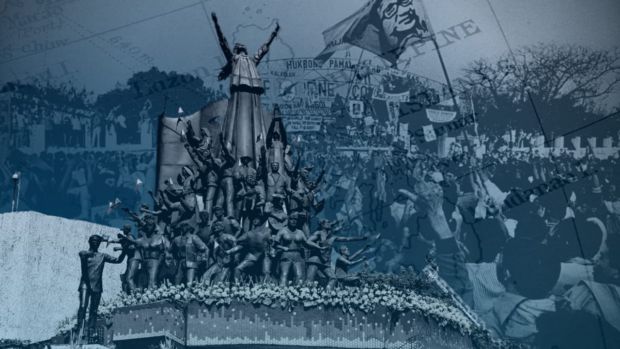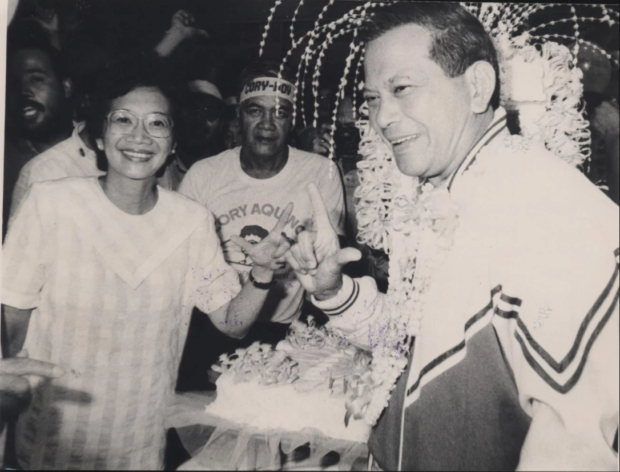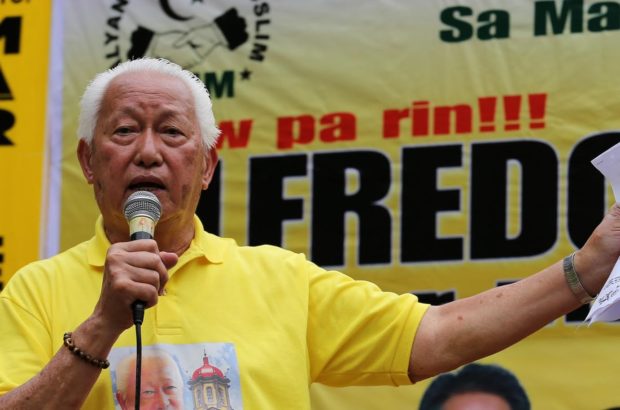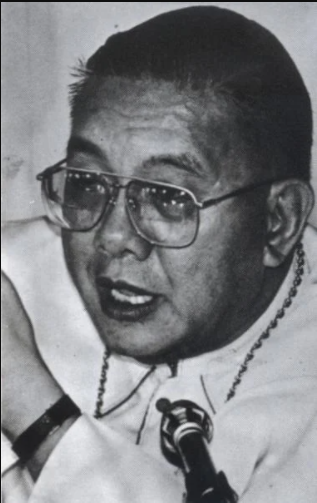36 years later: The key figures in Edsa People Power (Part two)
MANILA, Philippines—This year, as the nation observes the 36th anniversary of the Edsa People Power Revolution—which successfully overthrew dictator Ferdinand Marcos—INQUIRER.net looks back at the notable personalities whose names were etched in history as key figures in the four-day uprising.
Roilo Golez
Appointed as postmaster general by Marcos in 1981. Before and after the Feb. 7, 1986 election, he was everywhere on TV predicting a Marcos victory. However, on Feb. 22, he arrived at Camp Aguinaldo to support Defense Secretary Juan Ponce Enrile and AFP vice chief of staff Gen. Fidel Ramos.
He later read his irrevocable resignation over the radio. He became the first senior government official to officially resign from the Marcos administration after Enrile and Ramos.
He served as national security adviser from 2001 to 2004 during the time of former president Gloria Macapagal Arroyo. He also served as congressman in Parañaque for six terms.
Golez was also known for being vocal and active in discussions about the government’s handling of the dispute in the South China Sea, as he fiercely advocated for the Philippines’ rights to the West Philippine Sea.
Article continues after this advertisementA few hours before he died on June 11, 2018, he discussed defending the Philippines’ sovereignty in the South China Sea for the last time.
Article continues after this advertisementREAD: Golez, former national security adviser; 71
Gregorio Honasan
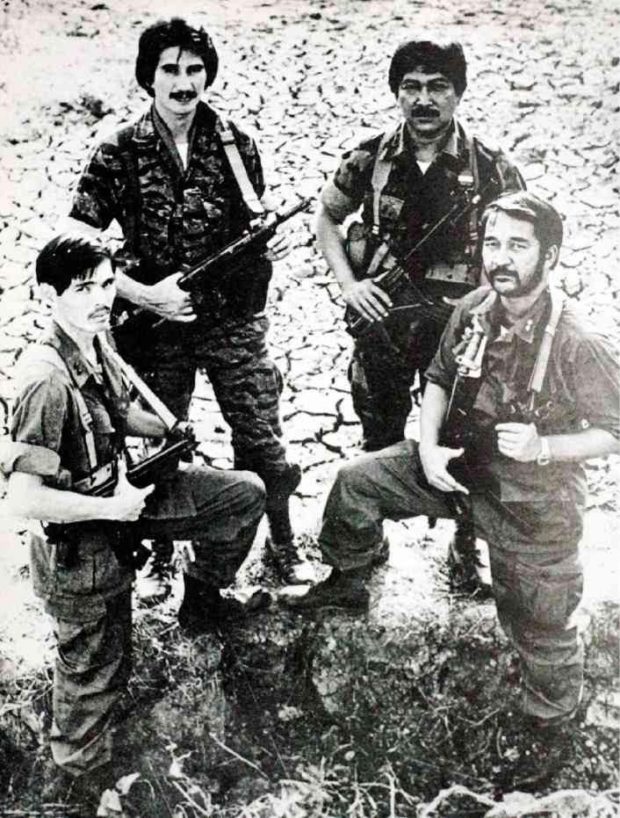
Honasan with fellow RAM boys Eduardo Kapunan, Rey Rivera and Tito Legaspi. PHOTO FROM ‘BREAKAWAY: THE INSIDE STORY OF THE FOUR-DAY REVOLUTION IN THE PHILIPPINES’
Enrile’s chief security aide cofounded the RAM with four others in 1982 following reports of plans to eliminate Enrile and the “MND (Ministry of National Defense) boys.” Also one of the masterminds behind the Malacañang assault, together with Col. Eduardo Kapunan and Col. Victor Batac. On learning that Malacañang had fortified its troops against RAM, Honasan and Kapunan convinced Enrile to fly to Cagayan and hide, but Enrile instead decided to regroup at Camp Aguinaldo.
Honasan has been tagged in the November 1986, July 1987 and December 1989 coup attempts against the Corazon Aquino administration and was imprisoned for some time. He was granted amnesty in 1995, the same year he won in the senatorial elections.
He served as senator from 1995 to 2004 and was re-elected in 2007 and in 2013. During the 2016 elections, he ran for vice president with then-presidential candidate Jejomar Binay as his running mate. Both lost.
In 2019, Duterte appointed Honasan as the new secretary of the Department of Information and Communications Technology (DICT). Last year, he filed a certificate of candidacy (COC) for senator in the May 2022 elections.
Eduardo Kapunan
Air Force Lt. Col. Eduardo “Red” Kapunan was an original member of RAM and was among the first few AFP officers who openly went against Marcos early on.
According to the RAM plot, Kapunan and Lt. Col. Rodolfo Aguinaldo would lead the group that would attack the Presidential Guards on the south bank of the Pasig River. His group would complement Honasan’s smaller assault team, which was to capture Marcos at dawn of Feb. 23. When the plot was uncovered, Kapunan and other RAM members took a last stand in Camp Aguinaldo with Enrile.
In 2017, Kapunan was designated as Philippine ambassador to Myanmar. He also currently serves as Philippine ambassador to Germany.
Salvador “Doy” Laurel
The former senator organized the opposition during the martial law years and gave up his presidential ambitions in favor of Corazon Aquino in the 1986 snap elections that preceded EDSA.
He took oath as vice president on Feb. 25—Day 4 of the uprising—and was appointed prime minister in the Cory administration. In September 1987, Laurel resigned from the foreign affairs post, citing differences with Aquino on the insurgency and other issues.
In 1992, Laurel ran for president under the banner of the Nacionalista Party but lost. From 1996 to 1999, he served as chair of the Philippine National Centennial Commission.
He retired from politics and stayed in the United States where he succumbed to lymphoma in 2004.
READ: Doy Laurel: Forgotten patriot of Edsa I
Alfredo Lim
Metropolitan Police chief who ignored orders to disperse the crowds at Edsa who were there to protect military rebels holed up at Camp Crame. Malacañang had sent tanks to assault Crame but could not get through the crowds. Lim’s order was to disperse the crowd of less than 1,000 with the 800 policemen he had with him on Day 2, but he refused. On Feb. 25, Lim and his men entered Camp Crame and were welcomed by Ramos.
Lim was mayor of Manila from 1992 to 1998 and 2007 to 2013. He also served as Department of the Interior and Local Government (DILG) chief under former President Joseph Estrada from 2000 to 2001, and a senator from 2004 to 2007.
He served again as Manila mayor from 2007 to 2013. His reelection bid in 2013 against Estrada was unsuccessful. In 2019, he ran for mayor again but lost to Francisco “Isko Moreno” Domagoso.
Lim died on Aug. 8, 2020 at age 90.
READ: Ex-Manila mayor Alfredo Lim dies at 90
Fidel Ramos
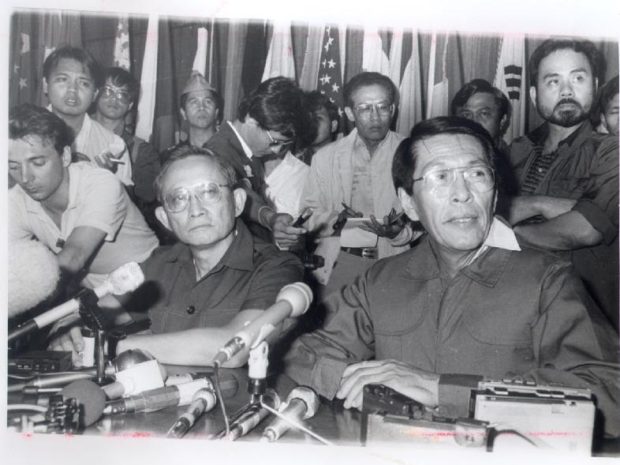
Fidel V. Ramos with Juan Ponce Enrile at a press conference to announce they were breaking from the Marcos regime. INQUIRER FILE PHOTO
Under the Marcos administration, Ramos was chief of the Philippine Constabulary (forerunner of today’s Philippine National Police) and vice chief of staff of AFP. During the Edsa uprising, he withdrew support from Marcos and joined Enrile’s planned coup as leader of military and police operations.
When he heard the premature news that Marcos had left Malacañang on the third day of Edsa, Ramos jumped with joy, an iconic image he would use in his presidential bid in 1992. He served as President until 1998.
Ramos also played a key role in the second Edsa Revolution—or Edsa II—a series of protests on Jan. 16-20, 2001 against then-president Estrada.
READ: Edsa 1 and Edsa 2 compared
In July 2016, he accepted Duterte’s offer to become special envoy to China. A few months later, on Oct. 31, he resigned from his post.
READ: Ramos accepts Duterte offer to become special envoy to China
READ: Fidel Ramos quits as special envoy to China
In June last year, the 93-year-old Ramos received his second dose of vaccine against COVID.
READ: LOOK: Former president Fidel Ramos completes COVID-19 vaccination
Fr. James Reuter, Sister Sarah Manapol, Pablo and Gabe Mercado
Despite threats of arrest by the pro-Marcos military, Keithley ran the clandestine “Radyo Bandido” with Fr. James Reuter and Sister Sarah Manapol and broadcast updates of the events unfolding on Edsa from Feb. 22 to 25.
Pablo and Gabe Mercado (then 13 and 15 years old, respectively) volunteered and helped Keithley at the secret station, while Manapol provided the information for broadcast.
Fr. Reuter died on Dec. 21, 2012 at age 96.
READ: Reuter, 1986 Edsa ‘Bandido,’ legendary Jesuit, dies at 96
Jaime Cardinal Sin
The Archbishop of Manila became a driving force in ousting Marcos when he sounded the clarion call for people to mass on Edsa to defend the military rebels led by Enrile and Ramos.
READ: #INQStory Cardinal Sin calls on Filipinos to support Ramos and Enrile
Millions heeded Sin’s plea for people to flock to Camp Aguinaldo and Camp Crame, protect, and supply food to the rebels led by Enrile, Ramos, and the RAM.
Sin, who was honored as ‘Liberator of Filipinos’, was also a key personality during Edsa II, which overthrew Estrada in 2001.
He died in 2005 at age of 76 due to renal failure.
Fabian Ver
Fabian Ver was the trusted AFP chief of Marcos. On Feb. 22, Day One of the revolt, US Ambassador to the Philippines Stephen Bosworth and Philip Habib, US President Ronald Reagan’s “trouble-shooter” told Marcos of the worsening political crisis and the need to remove Ver from office.
Ver fortified the Palace upon discovering the impending coup by RAM. He and Ramas also ordered that Radio Veritas be destroyed and that troops loyal to Marcos launch a final “suicide assault” against the rebel forces on the afternoon of Feb. 24. He and his family fled to Hawaii with the Marcoses on the evening of Feb. 25.
The Marcos loyalist was accused and charged as a principal in the double murder of Ninoy Aquino and Rolando Galman. In 1985, the Sandiganbayan acquitted him and other military respondents. Ver was charged as an accomplice in a new trial ordered by the Supreme Court. But he was not tried in his absence and the case against him has been shelved.
He died on Nov. 21, 1998 in Bangkok due to a lung ailment. He was buried in his hometown of Sarrat, Ilocos Norte.
Part one: Edsa People Power after 36 years: Who played key roles? (Part one)
TSB
RELATED STORIES
Marcos’ martial law: Golden age for corruption, abuses
People Power did not just happen at Edsa
